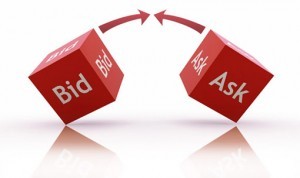 The bid price and ask price are two of the most quoted, yet at the same time least understood, share price metrics available to stock market investors. Together the two price metrics give birth to a more complex metric called the bid-ask spread, but for now the focus will be on the basic price metrics.
The bid price and ask price are two of the most quoted, yet at the same time least understood, share price metrics available to stock market investors. Together the two price metrics give birth to a more complex metric called the bid-ask spread, but for now the focus will be on the basic price metrics.
In the context of stock markets, the bid price is the highest share price that a buyer is willing to pay for stock of a corporation at a specific time. The prevailing bid price is also the price that an investor must pay if he wishes to purchase a given share of stock. For example, if the current share price for a security is $100.00 and the current bid price is $100.05, an investor will have to pay $100.05 for each share. In contrast to the bid price, the ask price is the lowest share price at which a seller is willing to sell stock of a corporation at any given time. The prevailing ask price is also the price at which an investor must offer her stock if she wishes to sell it. The difference between the bid price and ask price is called the bid-ask spread.
Neither the bid price nor the ask price alone tells much about whether or not an investor should invest in a given stock. However, when taken together the bid price and ask price give birth to the bid-ask spread, which can give helpful signals. The bid-ask spread will be covered in more detail in a future post. For now just remember that you will pay the bid price if you wish to purchase stock and will offer your stock at the ask price if you wish to sell it.
